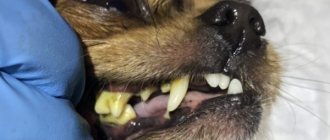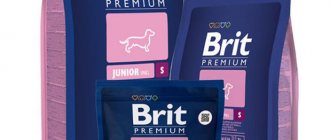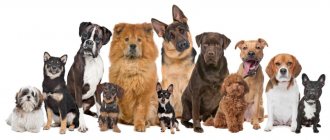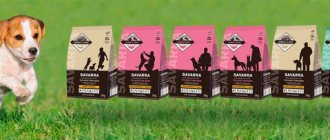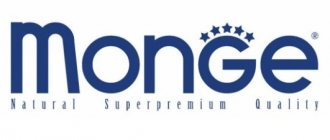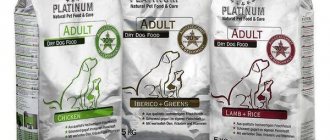Many dogs are susceptible to allergies, which can present with very severe symptoms and have serious consequences for the dog's health. The most common food allergy occurs. Once it has arisen, it will not disappear anywhere. The dog will have to take medications. The question immediately arises about changing the diet. Isolating an allergen is not so easy. Even those dogs that are fed a natural diet are forced to switch to dry food.
Any food will not work, even if it is selected from the premium or super premium line. Such dogs need only hypoallergenic food in their diet. You will have to choose by trial and error; I give you that among the special medicinal foods there are those that can cause a negative reaction in the dog’s body. From the article you will learn: why food allergies occur, what is included in hypoallergenic food, which are considered the best.
Causes of food allergies
Any allergy is the body’s reaction to a substance to which it is hypersensitive or completely intolerant. A food allergy means that there is a substance in your pet's diet that his body does not have enough enzymes to break down. Or they simply don't exist. Foods that most often cause allergic reactions in dogs:
- cereals;
- soy;
- corn;
- chicken meat;
- yeast;
- preservatives;
- dyes;
- flavorings;
- some types of fish and seafood;
- dairy products;
- bakery products;
- honey;
- chocolate;
- eggs;
- offal;
- some types of fruits (citrus fruits, melon, strawberries, persimmons, peaches, apricots).
The list contains only those products to which allergies occur quite often. There is also an individual intolerance to the product by the dog. This means that a dog can have a reaction to the most harmless product. In addition, a reaction can also occur to dry food that does not contain hazardous substances.
General information
Characteristics of hypoallergenic food
Hypoallergenic food is food that is suitable for dogs with allergies to any food. Moreover, the composition of such foods is balanced in such a way as to provide the dog with complete daily nutrition, and they also contain a vitamin and mineral complex. Hypoallergenic foods undergo many clinical studies before they are sold.
NOTE! Hypoallergenic food can also be used for dogs without allergies for prevention, since they do not contain harmful unnatural components.
Choosing food for pets with allergies
When choosing hypoallergenic food, you need to be aware of the requirements that apply to them. The very first thing you need to understand is that they cannot be cheap. In their production, only high quality natural products are used. Low-priced food contains low-quality products, as well as taste enhancers, which make pets enjoy eating such food. However, cheap food does not benefit the dog’s body. Perhaps hair will begin to fall out, digestion will be disrupted, or irritation will appear on the skin.
REFERENCE! Hypoallergenic food cannot contain many components that are considered highly allergenic. These include: gluten, grains, chicken, beef, lamb, seafood, exotic fruits and vegetables, soy and others.
Composition of hypoallergenic feed
When producing hypoallergenic food, components are used that do not cause allergic reactions in dogs. In the production of cheap feed, game and low-quality by-products are used.
For normal functioning, dogs need a building material - protein. Premium food manufacturers include rabbit, lamb, horse meat, turkey, and duck in their composition. Only low-fat fish are used - pike perch, salmon and others. From cereals you can use rice, peas, oats. It is not allowed to use yeast, wheat, soy, or oatmeal because they trigger the development of various diseases. Vegetables make up a significant part of the food; carrots, zucchini, pumpkin, and broccoli are used. The fruits used are apples and grapefruit, which contain large quantities of vitamins. It is very good if the composition contains medicinal herbs.
Features of hypoallergenic food
This type of food is produced according to the principle of eliminating the allergen from the composition:
- replacement. For example, animal protein that is at risk (chicken) is replaced with a safer one (lamb, turkey). Replacing soybeans and corn with safe rice;
- changing the processing method to reduce activity. For example, the hydrolysis of animal protein, that is, the breakdown of whole elements into small ones with low molecular weight;
- maximum reduction or complete elimination of artificial components;
- additional inclusion in the food of probiotics and vegetables that normalize digestion.
Please note that only food with hydrolyzed ingredients can be called hypoallergenic with complete confidence. Diets that eliminate the popular allergen also contain other components that can cause a reaction in your dog. Hydrolysates can include any type of meat and grain. The process of enzyme treatment followed by drying at low temperatures makes almost any component of the food safe for the health of the dog.
What are they?
There are 3 types:
- Elimination diets. Such ready-made food does not contain the most common allergens: chicken, wheat, corn, soy, egg white, artificial preservatives, dyes and flavor enhancers. They are conditionally classified as anti-allergenic: after all, anything can cause hypersensitivity. For example, a pet may tolerate chicken well, but react negatively to lamb, although the first type of meat is considered an allergen, and the second is considered hypoallergenic. Therefore, you can select a menu of this type only based on the results of blood allergy tests.
- Monorations. Like previous foods, they do not contain common plant allergens. They differ in that they are made from a single source of animal protein: usually these are hypoallergenic types of meat (duck, rabbit, lamb) or rare types (buffalo, kangaroo meat). They are suitable if you know exactly what the dog is allergic to: for example, he cannot tolerate chicken and veal, but feels good on lamb and rabbit.
- Hydrolyzed. The only type that can be considered a complete hypoallergenic diet. They contain any variety of grains and meat. But the products are prepared using a special technology - hydrolysis. First, the ingredients are treated with special enzymes and then dried at low temperature. As a result, protein molecules are broken down into atoms with low molecular weight. In this state, the components are safe and do not cause symptoms of hypersensitivity.
How to choose hypoallergenic food
The owner will have to make the choice of food based on the result of the dog’s analysis. You can’t just come and buy the most expensive pack of specialized food in the store. The allergy may only get worse.
If symptoms of food intolerance are detected, the dog urgently needs to be shown to a veterinarian. The doctor will take a skin scraping (if scratching or peeling appears) and conduct a blood test to identify the allergen. The tests are done very quickly, but if you have to wait several days, the veterinarian will advise you to change your diet so as not to worsen the consequences of the disease.
During the recovery period, the dog will need to take antihistamines.
Important: the choice of medication and its dosage are carried out by a veterinarian.
Having received the analysis results, you can begin choosing food. Naturally, they choose from those that do not contain an identified allergen. If there are several of them or the analysis did not give an exact answer, it is worth paying attention to those in which the method of production of the main components is hydrolysis.
Selection principles:
- You should look for such compositions only in premium and super premium, holistic lines. Economy diets will not benefit your pet's health;
- take into account the dog’s age, activity, and physiological state;
- They buy small packages so that they don’t have to throw away a large amount of food if it doesn’t fit.
Feeding rules
To avoid problems, any new product or food should be introduced into the animal’s diet gradually. You shouldn’t pour a bowl full of food, worrying that your pet will remain hungry. High-quality food is quite filling and contains sufficient nutrients, so even a seemingly small portion will satisfy all the dog’s needs.
Each manufacturer indicates on the packaging all the necessary recommendations. The data on the front side tells you what breeds or sizes of dogs the food is intended for. The back contains information about the frequency of feeding per day and the size of one serving.
At first, for convenience, it is better for the owner to use scales so as not to make a mistake with the volume of food. In the future, the food can be easily measured by eye.
Some owners give their dogs hypoallergenic food as a preventative measure. When choosing food, you need to carefully study the information about whether it is suitable for constant nutrition. Some of them are recommended for use only to eliminate unpleasant symptoms.
Symptoms of allergies to conventional food
A reaction to food can occur both in childhood and at any time in a dog’s life. The most common symptoms of food allergies in dogs are:
- manifestations on the skin: itching, pimples, ulcers, blisters, eczema. Most often, eczema is localized in areas with little or no hair: on the face, between the toes, on the ears, in the groin, on the stomach;
- dry skin, dandruff;
- dullness of fur, heavy shedding;
- diarrhea, nausea, vomiting;
- swelling;
- discharge from the eyes, nose, ears;
- lethargy, refusal to eat;
- increased thirst;
- cramps, spasms.
This does not mean that if there is a negative reaction to food, the dog will experience all the symptoms listed in the list. It all depends on the severity of the disease.
The effect of food on a dog's coat
Incorrectly selected food for white dogs leads to the formation of red stains under the animal’s eyes. A metabolic disorder, which is caused by a diet that is not sufficiently balanced with essential substances, causes porphyritic coloring of the coat, which appears on the ears, lips, belly and paw pads.
When changing food, if it is needed due to an undesirable change in the color of the coat, the color takes on the usual white color, including the regrown colored hairs, because a change in diet changes the metabolism of the animal and, accordingly, the change in coat color.
The best anti-allergenic foods
It is impossible to choose one or two foods that would be universal and suitable for all dogs without exception. Based on reviews from veterinary specialists and animal owners, we can identify the most successful options that combine good composition, optimal cost, and high ratings.
For small breeds
Small breeds require special diets because they are more susceptible to any manifestations of allergies.
Husse Ocean Care mini
Made in Sweden
Cost: from 514 rubles per kg
Class: super premium.
Contains one source of protein (salmon) and one source of carbohydrates (rice). Monoprotein feeds are the safest option for feeding allergic animals. Also, the fish-rice combination is suitable for an elimination diet.
Pros: mono-protein food, valuable nutritional supplements (salmon oil, flax seed) to improve skin and coat condition, good balance for show animals as well. Free shipping.
Cons: high cost, rarely found in retail stores.
Husse dog food - composition analysis, reviews from owners and veterinarians
1st Choice Sensitive Skin&Coat Adult Lamb&Fish
The food line includes products for all breeds, including small breed dogs.
Made in Canada.
Cost: 2.72 kg - from 1300 rubles, 7 kg - from 2800 rubles.
The product belongs to the premium class. Animal protein is represented by lamb meat. Contains fish (herring), “good” cereals (rice), potatoes, mussels, vegetables, barley and oatmeal, and a vitamin complex.
Pros: protection of the skin, wool, presence of chondoprotectors, normalization of microflora. Affordable price.
Disadvantages: high calorie content (not suitable for dietary nutrition), potatoes and rice themselves can cause allergies in dogs, not suitable for feeding castrated animals (contains fish).
1st choice dog food - full review of the line
Akana
Made in Canada.
Cost: 2 kg - from 1300 rubles, 6 kg - from 2800 rubles, 15 kg - from 5500 rubles.
Class: holistic.
The wide range contains diets for puppies, older dogs, large and small breeds. Ingredients: animal protein is represented by those types of meat that have a low allergenic index (meat of wild animals), grains are replaced with legumes, fruits (apples, pumpkin), a complex of medicinal herbs.
Pros: no artificial ingredients, suitable for dogs with gluten intolerance, availability in stores, low cost.
The disadvantages include the availability of diets in which the manufacturer includes chicken and beef.
Akana dog food - full review of the line
Brit
Production: Czech Republic.
Cost: 3 kg - from 560 rubles, 8 kg - from 1300 rubles, 15 kg - from 2200 rubles.
Class: super premium.
The food line includes diets for small breeds. Animal protein is represented by the least allergenic types of meat: lamb, venison, salmon, etc. Ingredients: rice or potatoes, dried vegetables, a complex of vitamins and minerals.
Pros: wide range, products with chondroprotectors, low price.
Cons: poor composition, presence of chicken and potatoes in some diets.
Brit dog food - expert reviews and detailed analysis of the composition
Eukanuba Dermatosis FP Response
Production: Netherlands.
Cost: 1 kg - from 500 rubles, 5 kg - from 2000, 15 kg - from 4500 rubles.
Class: super premium.
High-quality medicinal food for dogs of small breeds with strong external manifestations of the disease. The line consists of only one type of food, which is suitable for all dogs. Only the serving size differs.
Compound:
- meat is replaced by several types of fish;
- potato;
- animal fat;
- dried beets;
- vitamins and minerals.
Pros: high quality ingredients, no grains (suitable for dogs with gluten intolerance), no “meat” allergens.
Cons: high calorie content, diet not suitable for neutered pets, strong fishy smell, difficult to find on store shelves.
Eukanuba dog food - reviews and composition analysis
For large and medium breeds
Dry food for large and medium-sized dog breeds should have increased calorie content to maintain the dog’s activity, and chondroprotectors to protect joints. In this case, the composition must be balanced, including only such components that will not cause a negative reaction from the body.
Husse Digest
Made in Sweden
Cost: from 450 rubles per kg.
Class: super premium.
The composition is minimalist, which makes it most suitable for feeding animals with food allergies. The main ingredients are lamb and rice. It also contains salmon meat and valuable nutritional supplements.
Pros: large amount of meat, simple composition without allergenic plants and additives, good balance for show animals as well. The line includes food for puppies and giant breed dogs. Free shipping.
Cons: Rarely found in retail stores.
Husse dog food - composition analysis, reviews from owners and veterinarians
Grandorf Duck & Potato Adult All Breeds (Grandorf)
Production: Belgium.
Cost: 1 kg - from 650 rubles, 3 kg - from 1600, 12 kg - from 5500 rubles.
Class: holistic.
There is only one type of this food available. Although the manufacturer offers a wide range of other diets.
Compound:
- poultry meat (duck, turkey);
- sweet potato;
- sea krill;
- composition of medicinal herbs;
- citrus extract;
- vitamin complex;
- apples.
Pros: high quality ingredients, no grains, high percentage of protein.
Cons: age restrictions (for adult dogs only), seafood and citrus fruits can cause allergies, high cost and calorie content, difficult to find in the store.
Grandorf dog food - full review of the line and reviews from experts
GO! Daily Defense Lamb Meal Recipe (GOU)
Made in Canada.
Cost: 2.72 - from 1800 rubles, 5.5 kg - from 2500 rubles, 11.35 kg - from 4300 rubles.
Class: holistic.
There is only one diet in the line.
Compound:
- lamb;
- cereals;
- brown rice, unpolished;
- seaweed;
- vegetable oil;
- bran;
- complex of medicinal herbs;
- vitamins and minerals.
Pros: no grains, allergenic meats, low cost of feed with high quality ingredients.
Cons: no animal fats, many carbohydrates, high calorie content, narrow range.
Dog food GO!: analysis of ingredients, reviews from owners and veterinary specialists
Hills Prescription Diet Canine Allergen-Free (Hills)
Production: Netherlands.
Cost: 3 kg - from 2500 rubles, 10 kg - from 5900 rubles.
Class: super premium (therapeutic and preventive nutrition).
There is only one similar type of food in the line; there is no division by age or breed. Not only dry food is produced, but also wet food. The form of processing of the components is hydrolysis.
Compound:
- chicken liver (hydrolyzed);
- potato;
- soybean oil;
- corn flour;
- animal fats.
Pros: no “chemicals”, hydrolysates in the composition, low calorie content, affordable, animal fats.
Cons: Corn and potatoes, only one type of dog food.
Hill's dog food - complete review of the line
Pro Plan ADULT MEDIUM Sensitive Skin OPTIDERMA (Pro Plan)
Manufacture: France (Russia).
Cost: 3 kg - from 1300 rubles, 7 kg - from 2500, 14 kg - from 4000, 18 kg - from 3800 rubles.
Class: premium.
The food is divided into types: for medium, large and small breeds of dogs.
Compound:
- protein - dehydrated sea fish;
- rice;
- animal fats;
- corn;
- soy;
- dry beets;
- natural flavoring;
- cellulose;
- egg powder;
- vegetable oil;
- vitamins and minerals.
Pros: low cost (the larger the package, the lower the price), dehydrated components are better absorbed by the dog’s body, availability.
Cons: not suitable for neutered animals; eating soy, corn, fish may cause a reaction.
Reviews and detailed analysis of the Purina Pro Plan dog food line
MONGE Specialty Line Hypoallergenic (Monge)
Made in Italy.
Cost: 12 kg - from 4800 rubles.
Class: holistic.
The food contains several types of fish: tuna and salmon. Such protein sources do not cause allergies, nourish, reduce inflammation and improve the condition of the skin. Owners note a good therapeutic effect of the food, but poor pet addiction. The diet has a fishy smell, so many dogs refuse to eat.
Pros: rich in Omega 3 and Omega 6, glucosamine for joints, mineral composition, vitamins.
Cons: contains chicken meal - a source of allergens, narrow range, not always available on store shelves.
As can be seen from the analysis of the ingredients, almost every dog food, even the most expensive, can contain components that can cause a reaction. This means that diets are selected carefully, carefully monitoring the pet. It is necessary to constantly examine the dog for any unpleasant symptoms.
Monge food for dogs - reviews from veterinarians and a detailed analysis of the line
What are they made from?
In the production of hypoallergenic food, raw materials are used that are almost guaranteed not to cause a negative reaction in the animal. Economy class diets include game that is not of the best quality (for example, chicken) and offal.
Good to know: TOP 10 dry and wet food
In this case, the dog needs protein, which is the main building material. Manufacturers with a good reputation use lean varieties of meat as its source: lamb, rabbit, horse meat, as well as duck and turkey. From grain crops, a small amount of rice, oats, and peas is acceptable.
In the composition of food for dogs prone to allergies, they try not to use those components that provoke various disorders - soy, wheat, oatmeal, yeast. They are a trigger for the development of various diseases. Diets with fish contain only low-fat marine varieties (salmon, pike perch and others).
Expert opinion
Anna Abramenko
An avid dog lover. Experience in veterinary medicine since 2009.
Ask a Question
Vegetables that do not cause bloating are essential - zucchini, carrots, broccoli, pumpkin. Grapefruit, apples, and goji berries have antioxidant properties and are a storehouse of vitamins. Responsible manufacturers include beneficial medicinal herbs - mint, fennel, rosemary, chamomile, chicory.
Large amounts of protein are harmful to dogs. In order to reduce its content, animal proteins are hydrolyzed. At the same time, they are divided into small particles that do not pose a danger.
Basic principles of feeding
After identifying an allergy in a dog, it needs to be switched to a completely new regime. How to proceed:
- Visit your veterinarian for a blood test or patch test. These manipulations will identify the allergen;
- The dog is put on an elimination diet. The intended irritant is removed from the diet;
- when choosing a new food, you need to combine, look for “your” option: change the composition, amount of fat, fiber;
- Don't always trust the labels on the packaging. Research has shown that about 45% of diets contain ingredients that the manufacturer did not indicate on the product packaging. Note that this study did not concern brands. which use hydrolysis in production. It is worth listening to the opinion of the veterinarian and other owners;
- switching to hypoallergenic food means that the dog will always eat it. It is worth choosing from the average price range, counting on the fact that now the cost of feeding your pet will increase;
- It is necessary to follow all the rules for feeding dry food: water must be available (clean and cool), drying should not be soaked unnecessarily. If you decide to soften the crackers with liquid (for example, for a puppy or an elderly dog), after feeding it, immediately put it in the refrigerator or throw it away.
Primary requirements
In order to choose the right food for allergic dogs, you need to know the requirements for them. Firstly, they cannot have a low price. Secondly, only natural and high-quality components are used in their production.
This is interesting: Feeding standards for large and small breed puppy
Manufacturers of cheap products save on this by using low-quality raw materials, as well as flavorings that make the dog enjoy eating. But such food only harms the pet’s body. Irritation begins to appear on the skin, hair falls out, and digestive upset occurs.
There is a strict list of what should and should not be included in hypoallergenic food. Gluten, corn, soy, and other hard-to-digest components are prohibited. Exotic fruits and vegetables, chicken, lamb and beef, grains, cabbage and tomatoes, and much more are highly allergenic.
Hypoallergenic dry dog food necessarily includes all the necessary nutrients, minerals, vitamins, fiber, and prebiotics that have a beneficial effect on the animal’s gastrointestinal tract. Characterized by the absence of unsaturated fats, proteins, and gluten. Amino acids and medicinal herbs, on the contrary, will only benefit the dog.
Briefly about the main thing
- Food allergies in dogs are the most common type of disease.
- It can appear in childhood or at any time in life.
- There is a whole list of products to which reactions most often occur.
- The symptoms are different, one or the other may appear. It all depends on the degree of damage to the body.
- At the first symptoms, you should visit a veterinarian for testing to identify the allergen.
- The dog is put on an elimination diet, removing from its diet everything that is suspect.
- Start taking antihistamines prescribed by the doctor.
- Select food that is declared by the manufacturer as hypoallergenic.
- The choice is made from premium, super premium or holistic formulations.
- Selection is carried out by buying small packages of dry food, carefully observing the body's reaction.
- Choose a product that is affordable and available in stores.
There is no universal food that can be recommended for an allergenic pet. Even the most expensive products can contain components that can cause a negative reaction. The main thing for the owner is to identify the initial irritant and be prepared for the fact that the dog may be allergic to other ingredients of the composition.
Does your pet have food allergies? How was the type of allergen determined? What guided you when selecting special food? What brand did you choose? Share your experience in the comments, please. Your opinion is very important to us.
Criterias of choice
If a dog has a food allergy, the owner must be especially careful about its nutrition. It is necessary to take into account all the criteria for selecting hypoallergenic food.
- The diet should belong to the holistic or super premium class. Such food can provide the dog with all the necessary nutrients, and its owner will not have to worry that the pet is not getting enough.
- When purchasing, you should carefully study the composition - it should not contain those components to which the animal is intolerant.
- In addition to allergens specific to the dog, the composition should not include artificial components or ingredients to which the dog is likely to be allergic.
- Food for small breeds will not be suitable for large dogs, and the puppy’s menu will differ from the diet of an adult. Therefore, it is necessary to take into account the following characteristics of a pet when choosing: age, breed, size, other characteristics (sterilization, pregnancy, reduced activity and others).
Expert opinion
Anna Abramenko
An avid dog lover. Experience in veterinary medicine since 2009.
Ask a Question
You should pay close attention to the ratio of food ingredients. Meat should be at least 60%. It is indicated in the first places of the composition. The exception is food intended for dogs that cannot tolerate animal protein.
Veterinarian recommendations
If your puppy has a food allergy, you can switch him to natural food or hypoallergenic dry dog food. If you choose the second option, then you should remember that the product should not only satisfy the animal’s hunger, but also enrich its body with all the necessary substances for normal life.
In this matter, many breeders are afraid of the price of premium and super class food. Indeed, good hypoallergenic dry food cannot be cheap.
Today, manufacturers of dry dog food can be divided into those who sell food:
- Economy class.
- Premium class.
- Super premium.
Practice shows that the most popular brands are not of such high quality and may still contain components that cause allergies. But this does not at all prevent breeders from conducting experiments, identifying the optimal nutrition for their puppies of small and large breeds.
When choosing food for your pet, you should take into account its age, activity, and external parameters (as when purchasing regular ready-made dry food). Some manufacturers sell a therapeutic and preventive line of hypoallergenic food, while others simply offer food for small or large dogs that exhibit symptoms of food allergies.
Video “Protein Allergy in Dogs”
This video covers the most common protein allergy in dogs.
Was this article helpful?
Thank you for your opinion!
The article was useful. Please share the information with your friends.
Yes (100.00%)
No
X
Please write what is wrong and leave recommendations on the article
Cancel reply
Rate the benefit of the article: Rate the author ( 7 votes, average: 2.86 out of 5)
Discuss the article:
